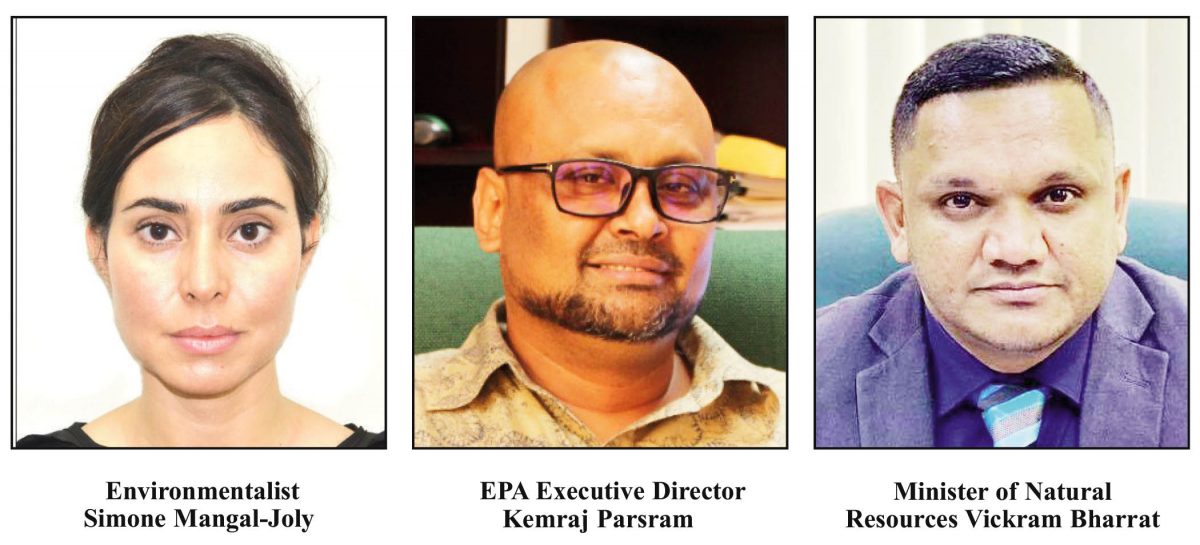Saying that the Environmental Protection Agency (EPA) “systematically and knowingly” violated the law, environmentalist Simone Mangal-Joly is contending that the environmental permit issued for ExxonMobil’s Yellowtail Development Project is “illegal and Invalid” as a result.
Mangal-Joly addressed some of the breaches in an open letter sent yesterday to the Executive Director of the EPA Kemraj Parsram. The letter, in its entirety, is published in today’s Sunday Stabroek.
“The EPA has systematically and knowingly violated the Environmental Protection Act in its handling of ExxonMobil’s local subsidiary EEPGL’s Yellowtail Project environmental assessment and permit process,” Mangal-Joly writes in the letter.
On March 30, 2022, the EPA granted the environmental permit to Exxon and just two days later the production licence was issued.
The environmental permit was stoutly contested, with environmentalists calling for the process to be cancelled since they say Exxon consultant Environmental Resource Management (ERM) did not address critical environmental concerns about the impact of the project. ERM submitted the Environmental Impact Assessment (EIA) and other ancillary documents as part of the process and held public consultations. Critics have questioned ERM’s independence since it has conducted all of the environmental studies for Exxon’s projects in Guyana.
As part of the Yellowtail Project, ExxonMobil plans to drill between 45 and 67 wells for the 20-year duration of the investment. It is intended to be the largest of the four developments with over 250,000 barrels of oil per day targeted once production commences. Based on the schedule, once approval is granted, engineering commences this year and production in the latter part of 2025.
In her open letter to the Executive Director of the EPA, Mangal-Joly highlighted four areas where she said the EPA committed violations of the Act during the process leading up to the granting of the permit. The main violation, she said, stemmed from the beginning of the process where the EPA failed to disclose the Terms of Reference (TOR) for the EIA, ultimately denying the public adequate participation.
The TOR for a study specifies the obligations consultants are required to fulfil in the conduct of the study and the EPA failed to disclose the TOR for the Yellowtail EIA during the full duration of the statutory 60-day comment period. The TOR was released on December 13, 2021 – two days before the end of the public participation process – and after a letter was sent, by Mangal-Joly, to the Environmental Protection Board complaining. The EPA had also said that it was not required to disclose the TOR.
Mangal-Joly reminded that Section 11(6) of the EPA Act requires that before an impact assessment is begun, the EPA shall publish a notice to the public with a project summary. Section (11)(7) specifically states that: “Members of the public shall have 28 days from the date of publication referred to subsection (6) to make written submissions to the agency setting out those questions and matters which they require to be answered or considered in the environmental impact assessment.”
She argued that while Sections 11(4) and 11(5) of the Act provide general guidance in the conduct of an EIA, Sections (11)(6) and (7) provide the necessary specificity for assessing each application through the development TORs. She added that although the EPA held public meetings, it still knowingly violated the law when it withheld the TORs for almost the entire process.
She also argued that the Agency breached the Act when it failed to assess the significant impacts before granting the permit.
“The EPA illegally deferred the assessment of impacts to the Environmental Permit. For example, Section 1.3 of the permit specifies that: ‘The Permit Holder shall conduct an updated targeted marine environmental baselines studies program to develop a robust understanding of the marine environment within the area of influence (AOI) of the Yellowtail project.’ Among the listed requirement is 1.3.c: ‘Fisheries stock assessment and impacts.’
“It is well established in law that deferring the assessment of impacts defeats the whole purpose of an environmental impact assessment. This deferral is procedurally incorrect, irrational, and illegal. The EPA’s core responsibility is to assess impacts and based on the findings, determine whether a permit should be granted for an activity,” the letter stated.
Mangal-Joly added that the EPA has “disgracefully reneged on this responsibility” to the Guyanese people by mandating Exxon to assess the impacts of its own projects.
Section 12(1) (a)(b) and (c) of the Act direct the EPA to consider: (i) Recommendations of the EAB; (ii) Views expressed during consultation under section 11(9); and (iii) The EIA and statement in deciding on a permit. Notably, Section 12(2) compels the EPA to account for its decision: “The Agency shall publish its decision and the grounds on which it is made”.
The environmentalist also accused the EPA of violating those processes in the law when it did not publish the reasons for granting the permit and instead issued a notice of decision. She said that the EPA is required by law to identify and account for how significant impacts and public concerns were satisfactorily addressed before it granted a permit.
One of the sore points during the public process was the fact that ERM is the only consultant hired by Exxon to conduct its environmental studies. In that regard, Mangal-Joly argues that the EPA knowingly failed to select the consultants according to the procedures specified in the EP Act.
The EPA previously said that it selects consultants on a “case by case” basis but Mangal-Joly posited that the Act does not provide for such.
“Whether one does it on a case-by-case basis or from a pool, or whether it is a local or foreign individual or company, Section 3(a) of the Act is clear that the Agency cannot select the consultants by itself; the selection must be done ‘with the assistance of internationally recognized environmental groups.’ This is specifically to avoid bias and underhandedness,” the letter said.
She added that despite the EPA receiving complaints of its violation during the public comment process for the Yellowtail project, it willfully ignored those contributing to rendering the permit illegal. She noted that the EAB is also complicit since it failed to investigate, even after promising to do so, the complaints lodged before it in writing on December 10, 2021.
“Given the circumstance, the public had a legitimate expectation that both the EPA and the EAB would have addressed outstanding concerns within the statutory public consultative framework before approving the permit. The matter of whether the revised EIA meets the basic requirements of the impact study as set out in Sections 11(4) and (5) and the Terms of Reference remains moot. Further, despite all the EPA’s claims of transparency and good governance, the public still has no sight of the so-called independent review that was conducted of the EIA. This is a relevant document that ought to have been placed on the National Register as per the EP Act,” Mangal-Joly said.
Release of production licence
Meanwhile, addressing the release of the production licence granted to EEPGL and its partners for the project, Minister Vickram Bharrat says that the companies have to work out “some internal arrangements” before the licence can be released to the public.
On Wednesday, Minister Bharrat told Sunday Stabroek that the government has all intentions to release the production licence for scrutiny but he could not say when that would be done.
“The production licence will be released because we did release Payara already but that will be done as soon as it is registered. There is some internal arrangement with the companies in EEPGL and after that and the environmental EPA permit and so are in order, we will release it,” he said on the sidelines of Wednesday’s parliamentary sitting.
Pressed on what registration needs to be done and relating to the details of the arrangement, the minister indicated that he is not furnished with such information.
“I can’t say exactly what is it that they need to do and I also cannot say when it will be done but rest assured that the production licence will be released once everything is in order,” Bharrat added.
The speed with which the production licence followed the environmental clearance has resulted in concerns here that the government and ExxonMobil are moving to extract oil at breakneck speed no matter the environmental and climate concerns that persist.
Civil society group, Article 13 has already called on the government to release the production licence for the Yellowtail development and expressed consternation at the speed with which approval had come and the studies that still need to be done.
In a statement issued days after the announcement was made, Article 13 expressed skepticism that technical staff of the Ministry of Natural Resources were able to review and evaluate the 41-page environmental permit all in less than 48 hours.
“What stands out in this whole sordid business is not only that the Environmental Protection Agency, the Environment Assessment Board and the Ministry of Natural Resources are unable to exercise independent judgement among themselves but that the Government seems willing to act in accordance with the dictates of the oil companies. Mindful of the law’s requirements for relinquishment of blocks, the oil companies must be only too pleased that the Government has delegated to them the determination of the country’s depletion policy!” Article 13 had said.
There are concerns that the government is moving at record speed when dealing with the development of the oil and gas industry. Government has already lashed out at several civil society bodies that raised this issue.







